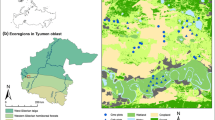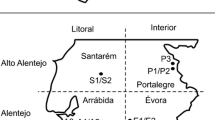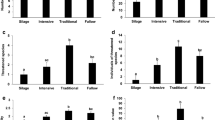Abstract
The present paper studies butterfly, grasshopper and vascular plant communities in ten seasonally flooded grasslands with different anthropogenic disturbance regimes (NW Greece). Disturbance intensity was assessed on the basis of disturbance frequency and type (grazing, mowing, trampling, constructions). The distribution patterns of butterflies are regulated by humidity and elevation (Redundancy Analysis). Elevation, flower-heads abundance, low disturbance intensity and plant species richness predict grasshopper species richness well, while the latter together with humidity predict plant species richness (Generalized Linear Models). Chorthippus lacustris, a critically endangered endemic grasshopper species, is positively associated with humid microhabitats with high flower-heads abundance. An indicator value procedure reveals four butterfly species as being typical species for habitats with a pronounced character of hedgerows and tree lines. Conservation management of grassland butterflies should focus on the maintenance of the humid character of the humid grasslands as well as on the maintenance of hedgerows and tree lines. The reduction of human-induced disturbance towards occasional grazing and mowing seems to benefit both butterfly and grasshopper communities. Finally, we suggest the use of grasshoppers as surrogates for vascular plants and vice versa, given their congruent species richness patterns.


Similar content being viewed by others
References
Battisti C, Luiselli L, Pantano D et al (2008) On threats analysis approach applied to a Mediterranean remnant wetland: is the assessment of human-induced threats related into different level of expertise of respondents? Biodivers Conserv 16:1529–1542. doi:10.1007/s10531-008-9360-1
Britten HB, Riley L (1994) Nectar source diversity as an indicator of habitat suitability for the endangered Uncompahgre fritillary, Boloria acrocnema (Nymphalidae). J Lep Soc 48:173–179
Chambers BQ, Samways MJ (1998) Grasshopper response to a 40-year experimental burning and mowing regime, with recommendations for invertebrate conservation management. Biodivers Conserv 7:985–1012. doi:10.1023/A:1008803513740
Connell HJ (1978) Diversity in tropical rain forests and coral reefs. Science 199:1302–1310
Corbet SA, Unwin DM, Prûs-Jones OE (1979) Humidity, nectar and insect visits to flowers, with special reference to Crataegus, Tilia and Echium. Ecol Entomol 4:9–22. doi:10.1111/j.1365-2311.1979.tb00557
Dafis S, Papastergiadou E, Lazaridou E, Tsiafouli M (2001) Technical manual of identification, description and mapping of Greek habitat types. Greek Biotope–Wetland Center, (EKBY), Thessaloniki (in Greek)
Dover JW, Sparks TH, Greatorex-Davies JN (1997) The importance of shelter for butterflies in open landscapes. J Insect Conserv 1:89–97. doi:10.1023/A:1018487127174
Dufrêne M, Legendre P (1997) Species assemblages and indicator species: the need for a flexible asymmetrical approach. Ecol Monogr 67:345–366. doi:10.1890/0012-9615(1997)067[0345:SAAIST]2.0.CO;2
Dunne T, Western D, Dietrich WE (2011) Effect of cattle trampling on vegetation, infiltration, and erosion in a tropical rangeland. J Arid Environ 75:58–69. doi:10.1016/j.jaridenv.2010.09.001
EEA (2010) EU 2010 Biodiversity Baseline. EEA Technical report No 12/2010. European Environment Agency, Copenhagen
Feber RE, Smith H (1995) Butterfly conservation on arable farmland. In: Pullin AS (ed) Ecology and conservation of butterflies. Chapman & Hall, London, pp 84–97
Fielding DG, Brusven MA (1995) Ecological correlates between rangeland grasshoppers (Orthoptera: Acrididae) and plant communities of southern Idaho. Environ Entomol 24:1432–1441
Gebeyehu S, Michael J, Samways MJ (2003) Responses of grasshopper assemblages to long-term grazing management in a semi-arid African savanna. Agric Ecosyst Environ 95:613–622. doi:10.1016/S0167-8809(02)00178-0
Gibbs JP (1995) Hydrologic needs of wetland animals. In: Nierenberg WA (ed) Encyclopedia of environmental biology, vol 2. Academic Press, New York, pp 267–276
Gibbs JP (2000) Wetland loss and biodiversity conservation. Conserv Biol 14:314–317. doi:10.1046/j.1523-1739.2000.98608.x
Gibson CWD, Brown VK, Losito L, McGavin GC (1992) The response of invertebrate assemblies to grazing. Ecography 15:166–176. doi:10.1111/j.1600-0587.1992.tb00020.x
Green AJ, Hamzaoui MEL, Agbani MAEL, Franchimont J (2002) The conservation status of Moroccan wetlands with particular reference to waterbirds and to changes since 1978. Biol Conserv 104:71–82. doi:10.1016/S0006-3207(01)00155-0
Grill A, Barbara K, Cleary DFR, Kati V (2005) Butterfly, spider, and plant communities in different land-use types in Sardinia, Italy. Biodivers Conserv 14:1281–1300. doi:10.1007/s10531-004-1661-4
Grotjahn F, Handke K (2000) Changes in the grasshopper fauna of the river marshes in Bremen from 1986 to 1997-increase of numbers of species and individuals in grassland areas. Naturschutz und Landschaftsplanung 32:97–105
Guido M, Gianelle D (2001) Distribution patterns of four Orthoptera species in relation to microhabitat heterogeneity in an ecotonal area. Acta Oecol 22:175–185. doi:10.1016/S1146-609X(01)01109-2
Guttiérrez D (1997) Importance of historical factors on species richness and composition of butterfly assemblages (Lepidoptera: Rhopalocera) in a northern Iberian mountain range. J Biogeogr 24:77–88. doi:10.1111/j.1365-2699.1997.tb00052.x
Hill JK (1999) Butterfly spatial distribution and habitat requirements in a tropical forest: impacts of selective logging. J Appl Ecol 36:564–572. doi:10.1046/j.1365-2664.1999.00424.x
HNMS (2000) Hellenic National Meteorological Society Web. http://www.hnms.gr/hnms/greek/index_html
Ingrisch S (1986) The plurennial life cycles of the European Tettigoniidae (Insecta: Orthoptera), 3. The effect of drought and the variable duration of the initial diapauses. Oecologia 70:624–630. doi:10.1007/BF00379915
Joern A (1979) Feeding patterns in grasshoppers (Orthoptera: Acrididae): factors influencing diet specialization. Oecologia 38:325–347. doi:10.1007/BF00345192
Kati V, Dufrêne M, Legakis A et al (2004) Conservation management for the Orthoptera in the Dadia reserve, Greece. Biol Conserv 115:33–44. doi:10.1016/S0006-3207(03)00091-0
Kati V, Mani P, von Helversen O et al (2006) Human land use threatens endemic wetland species: the case of Chorthippus lacustris (La Greca and Messina 1975) (Orthoptera: Acrididae) in Epirus, Greece. J Insect Conserv 10:65–74. doi:10.1007/s10841-005-2642-y
Kruess A, Tscharntke T (2002) Contrasting responses of plant and insect diversity to variation in grazing intensity. Biol Conserv 106:293–302. doi:10.1016/S0006-3207(01)00255-5
Legakis A, Maragou P (2009) The red data book of threatened vertebrates of Greece. Hellenic Zoological Society, Athens
Leuschner C, Lendzion J (2009) Air humidity, soil moisture and soil chemistry as determinants of the herb layer composition in European beech forests. J Veg Sci 20:288–298. doi:10.1111/j.1654-1103.2009.05641.x
Magurran AE (2004) Measuring biological diversity. Blackwell, Oxford
McCune B, Mefford MJ (1999) PC–ORD. Multivariate analysis of ecological data. Version 4. MjM Software Design, Gleneden Beach
Mitsch WJ, Gosselink JG (1993) Wetlands, 2nd edn. Wiley (formerly Van Nostrand Reinhold), New York
O’Neill KM, Olson BE, Rolston MG, Wallander R, Larson DP, Seibert CE (2003) Effects of livestock grazing on rangeland grasshopper (Orthoptera: Acrididae) abundance. Agr Ecosyst Environ 97:51–64. doi:10.1016/S0167-8809(03)00136-1
Pamperis LN (2010) The butterflies of Greece, 2nd edn. Koan, Athens
Plum N (2005) Terrestrial invertebrates in flooded grassland: a literature review. Wetlands 25:721–737. doi:10.1672/0277-5212(2005)025[0721:TIIFGA]2.0.CO;2
Psilovikos A (1992) Prospects for wetlands and waterfowl in Greece. In: Finlayson CM, Hollis T, Davis T (eds) Managing Mediterranean wetlands and their birds. Proceedings of an IWRB international symposium, Grado, Italy. IWRB Special Publication no. 20, pp 53–55
Pywell RF, Warman EA, Sparks TH, Greatorex-Davies JN, Walker KJ, Meek WR, Carvell C, Petit S, Firbank LG (2004) Assessing habitat quality for butterflies on intensively managed arable farmland. Biol Conserv 118:313–325. doi:10.1016/j.biocon.2003.09.011
Roxburgh SH, Shea K, Wilson JB (2004) The intermediate disturbance hypothesis: patch dynamics and mechanisms of species coexistence. Ecology 85:359–371
R Development Core Team (2009) R: A language and environment for statistical computing. Vienna: R Foundation for Statistical Computing. Available at: http://www.R-project.org
Sala OE, Paruelo JM (1997) Ecosystem services in grasslands. In: Daily GC (ed) Nature’s services: societal dependence on natural ecosystems. Island Press, Washington, pp 237–252
Samways MJ (1994) Insect conservation biology. Chapman & Hall, London
Sergeev MG (1998) Conservation of orthopteran biological diversity relative to landscape change in temperate Eurasia. J Insect Conserv 2:247–252. doi:10.1023/A:1009620519058
Stefanescu C, Herrando S, Páramo F (2004) Butterfly species richness in the north–west Mediterranean Basin: the role of natural and human-induced factors. J Biogeogr 31:905–915. doi:10.1111/j.1365-2699.2004.01088.x
ter Braak CJF, Smilauer P (2002) CANOCO Reference manual and canoco draw for windows user’s guide: software for canonical community ordination (version 4.5) microcomputer power. Ithaca, New York
Thomas JA, Telfer MG, Roy DB, Preston CD, Greenwood JJD, Asher J, Fox R, Clarke RT, Lawton JH (2004) Comparative losses of British butterflies, birds, and plants and the global extinction crisis. Science 303:1879–1881. doi:10.1126/science.1095046
Tscharntke T, Greiler HJ (1995) Insect communities, grasses, and grasslands. Annu Rev Entomol 40:535–558. doi:10.1146/annurev.en.40.010195.002535
UNEP (2004) Freshwater in Europe—Facts, Figures and Maps. United Nations Environment Programme-Division of Early Warming and Assessment-Europe, Chatelaine, Switzerland
Van Swaay C, Warren M, Loïs G (2006) Biotope use and trends of European butterflies. J Insect Conserv 10:189–209. doi:10.1007/s10841-006-6293-4
Van Swaay C, Cuttelod A, Collins S, Maes D, López Munguira M, Šašić M, Settele J, Verovnik R, Verstrael T, Warren M, Wiemers M, Wynhof I (2010) European red list of butterflies. Publications Office of the European Union, Luxembourg
Warren MS, Hill JK, Thomas JA et al (2001) Rapid responses of British butterflies to opposing forces of climate and habitat change. Nature 414:65–69. doi:10.1038/35102054
Wettstein W, Schmid B (1999) Conservation of arthropod diversity in montane wetlands: effect of altitude, habitat quality and habitat fragmentation on butterflies and grasshoppers. J Appl Ecol 36:363–373. doi:10.1046/j.1365-2664.1999.00404.x
Willemse F (1985) A key to the orthoptera species of Greece. Hellenic Zoological Society, Athens
Wilson RJ, Davies ZG, Thomas CD (2009) Modelling the effect of habitat fragmentation on range expansion in a butterfly. Proc R Soc Lond B 276:1421–1427. doi:10.1098/rspb.2008.0724
Zenetos A, Pancucci-Papadopoulou MA, Zogaris S et al (2009) Aquatic alien species in Greece (2009): tracking sources, patterns and effects on the ecosystem. J Biol Res-Thessalon 12:135–172. Available at: http://www.jbr.gr/papers20092/03-Zenetos%20et%20al.pdf
Zografou K, Sfenthourakis S, Pullin A, Kati V (2009) On the surrogate value of red-listed butterflies for butterflies and grasshoppers: a case study in Grammos site of Natura 2000, Greece. J Insect Conserv 13:505–514. doi:10.1007/s10841-008-9198-6
Acknowledgments
The present research was partially funded by Interreg IIIA Greece-Italy project (2006–2009). We are particularly grateful to project coordinator Prof. P. Dimopoulos for research support and fruitful advice. We also thank Theodora Pasxali for fieldwork assistance.
Author information
Authors and Affiliations
Corresponding author
Appendices
Appendix 1: Study sites

Sites | Coordinates | Environmental parameters | |||||||||
|---|---|---|---|---|---|---|---|---|---|---|---|
Latitude (N) | Longitude (E) | Habitat type | Alt (m) | Temp (°C) | Hum (%) | Herb height (cm) | Herb cover | F | TSh cover (%) | DT (m) | |
S1 | 39°38′8.12″ | 20°53′4.60″ | 6420* | 467 | 32 | 53 | 54 | 3 | 3 | 3 | <10 |
S2 | 39°32′2.15″ | 20°13′1.31″ | 6420* | 0 | 28 | 57 | 99 | 4 | 4 | 3 | 30 |
S3 | 39°32′59.57″ | 20°52′49.80″ | 6420 | 480 | 29 | 44 | 69 | 3 | 5 | 0 | 60 |
S4 | 39°55′7.28″ | 20°36′56.12″ | 6420 | 468 | 30 | 45 | 59 | 3 | 3 | 0 | >100 |
S5 | 39°48′17.50″ | 20°34′52.57″ | 6450 | 378 | 33 | 65 | 94 | 4 | 3 | 3 | 30 |
S6 | 39°28′48.36″ | 20°27′52.34″ | 6420* | 187 | 25 | 47 | 74 | 3 | 3 | 0 | 80 |
S7 | 39°35′48.66″ | 20°11′27.92″ | 6420* | 0 | 30 | 60 | 83 | 4 | 4 | 2 | 45 |
S8 | 39°32′11.44″ | 20°12′11.56″ | 6420* | 0 | 29 | 51 | 64 | 3 | 5 | 1 | 15 |
S9 | 39°32′49.02″ | 20°10′24.78″ | 1410* | 0 | 30 | 45 | 31 | 2 | 1 | 5 | 40 |
S10 | 39°18′18.79″ | 20°28′14.52″ | 6420* | 101 | 31 | 52 | 51 | 3 | 3 | 4 | >100 |
Appendix 2: Species inventory
Rights and permissions
About this article
Cite this article
Kati, V., Zografou, K., Tzirkalli, E. et al. Butterfly and grasshopper diversity patterns in humid Mediterranean grasslands: the roles of disturbance and environmental factors. J Insect Conserv 16, 807–818 (2012). https://doi.org/10.1007/s10841-012-9467-2
Received:
Accepted:
Published:
Issue Date:
DOI: https://doi.org/10.1007/s10841-012-9467-2




